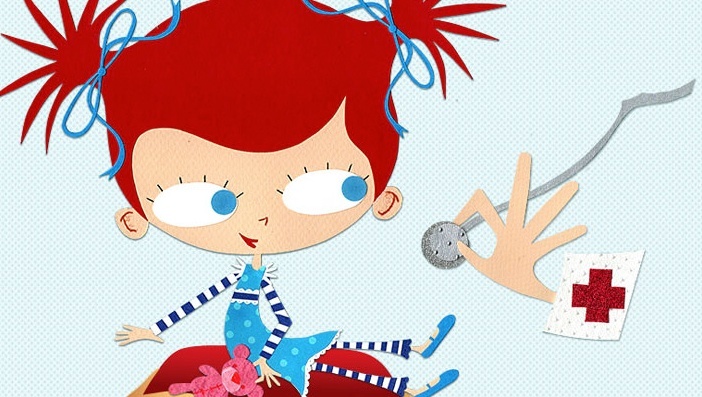Common Myths and Misconceptions about Immunisation: What You Need to Know

Where would we be without the Internet? I know I would be completely lost!
Even on days when I’m not furiously tapping away on my laptop working on an article or story, I seem unable to refrain from Googling something – be it recipe inspiration for dinner, to seek out a fact to solve a disagreement, or even just to research something that has grabbed my attention.
But when it comes to the Internet – it is also wise to be aware that not all sources are reliable. Whilst it can be a wonderful wealth of instantly accessible knowledge, it can also be a place where myths and false information abound.
As a parent, I know that the Internet and social media channels are generally the first place I turn to if I am concerned with a health matter that affects my family or me. Of course, if it is something requiring a Doctor’s attention I will ring my local GP to make an appointment, but more often than not I will look online in the meantime to gain some insight. However, I am always very particular about where I look for information regarding health matters, particularly around the issue of childhood immunisation.
I stick to reputable sites and information written by health experts.
The Importance of Immunisation
The NSW Health immunisation website has a great section with articles, videos and resources to help answer your questions and outline the facts.
Immunisation is the safest and most effective way to prevent diseases worldwide. In fact, it is estimated that vaccination currently saves approximately 3 million lives each year.
 During the first month of life babies are at their highest risk of catching potentially fatal diseases. Fortunately, we have the means to vaccinate against the most serious childhood infectious diseases, several of which need to be given several times to build long lasting protection. For this reason, it is important for children to complete the full recommended schedule at the recommended times.
During the first month of life babies are at their highest risk of catching potentially fatal diseases. Fortunately, we have the means to vaccinate against the most serious childhood infectious diseases, several of which need to be given several times to build long lasting protection. For this reason, it is important for children to complete the full recommended schedule at the recommended times.
NSW Health has developed an app that parents can download, free of charge, onto their smartphones which sends them reminders when their child is due for their next vaccination.
The ‘Save the Date’ app (download at www.immunisation.health.nsw.gov.au) is an easy-to-use application that gives parents a personalised immunisation schedule for each child. You just need to add their name, date of birth and GP or immunisation provider’s details.
Immunisation: The Myths and the Facts
There are a number of misconceptions about vaccines, and concerns about their safety, the most common of which are addressed below:
The following information is taken from www.immunise.health.gov.au
‘Vaccines are unsafe’
The facts:
All vaccines currently available in Australia must pass stringent safety testing before being approved for use by the Therapeutic Goods Administration (TGA), Australia’s regulatory authority for therapeutic goods.
This testing is required by law and is usually done over many years during the vaccine’s development. In addition, the safety of vaccines is continually monitored once they are in use, by the TGA and other organisations. Immunisation providers play an important role in reporting adverse events related to immunisation which assists in safety surveillance after vaccines are registered for use in Australia.
Vaccines may produce some undesirable side effects, such as pain and redness at the injection site or fever, but most reactions are mild and resolve quickly. It is usually not possible to predict who may have a mild reaction and who may have a rarer, serious reaction to a vaccine. However, the risk of adverse effects can be minimised by following guidelines regarding when vaccines should and shouldn’t be used.
People with an egg allergy:
Individuals with a severe allergy to eggs should still seek specialist advice.
Yellow fever, Q fever and one of the rabies vaccines contain a higher amount of ovalbumin and generally should not be given to people with known severe allergy to eggs.
The measles and mumps viruses for vaccines are grown in chick embryo cell lines, not in eggs. It is now recognised that measles-and mumps-containing vaccines (MMR and MMRV) contain negligible amounts of egg protein and can be given to children with egg allergy, even those with anaphylaxis to egg. If reassurance regarding the vaccination of a child with egg or other allergies is required, the child can be referred to a specialist immunisation clinic, paediatrician or infectious diseases specialist with a specific interest in immunisation. Specialist immunisation advice can be obtained from state or territory health authorities.
‘Vaccines are not adequately tested’
The facts:
Before vaccines are made available for use they are rigorously tested in thousands of people in large clinical trials, which are strictly monitored for safety. All vaccines registered in Australia by the TGA are manufactured and tested according to strict safety guidelines and are evaluated to ensure they are effective, comply with strict manufacturing and production standards, and have a good safety record.
The approval process can take up to 10 years. As a result of such detailed testing, a number of vaccines have failed in these early tests and have never been released.
‘Vaccines are contaminated with foreign viruses’
The facts
While bacterial vaccines are not grown in cells, viruses cannot survive outside of cells. Therefore, viral vaccines require cells in which the attenuated (weakened) vaccine viruses can be grown.
The viruses in current viral vaccines are grown in either the cells of chicken eggs (flu vaccines) or in cell lines (populations of a specific cell type which are grown continuously in the laboratory).
These cells are thoroughly screened for foreign (adventitious) agents such as other viruses or bacteria.
Any other materials or reagents used in the production of vaccines are also thoroughly tested for purity, sterility and for the absence of possible contaminants.
‘Vaccines contain toxic additives’
The facts
All vaccines marketed in Australia are assessed by the TGA to ensure they meet strict safety guidelines prior to being registered for use. This includes stringent testing for all vaccine components, including adjuvants, preservatives, additives and any manufacturing residuals.
Adjuvants, most commonly aluminium salts (known as alum), are added to some vaccines to enhance the immune response to the vaccine.
Aluminium intake from vaccines is lower than everyday intake from diet or medications, such as antacids, and is well below the levels recommended by organisations such as the United States Agency for Toxic Substances and Disease Registry.
A review of all available studies of aluminium-containing diphtheria, tetanus and pertussis vaccines (either alone or in combination) found that there was no evidence that aluminium salts in vaccines cause any serious or long-term adverse events.
More redness and swelling at the injection site is associated with aluminium-containing vaccines compared to those not containing aluminium, but this is usually mild.
‘Vaccines contain foreign proteins’
The facts
Depending on their purpose and specific composition, vaccines can contain live viruses, killed viruses, purified viral proteins, in activated bacterial toxins or bacterial polysaccharides.
Vaccines are complex pharmaceutical products which need to withstand transport, storage and environmental factors. To ensure they are stable over time, vaccines can contain additives, such as gelatin or albumin.
Furthermore, some vaccines contain tiny residual quantities of substances used during the manufacturing process, such as formaldehyde, antibiotics, egg proteins or yeast proteins.
An example of a question which arises relating to vaccines containing foreign material is the presence of egg proteins. Some vaccines, such as influenza, yellow fever and Q fever vaccines and one rabies vaccine, are grown in eggs and need to be given with caution to people with known egg allergy. The risk of an allergic reaction to these vaccines depends on the amount of egg protein (ovalbumin) in the vaccine and the extent of a person’s allergy.
The majority of influenza vaccines in use in Australia have only trace amounts of ovalbumin (less than 1 microgram) per dose and can be safely given to most people.
Preservatives are used in some vaccines to prevent bacterial and fungal growth.
Preservatives are required when vaccines are produced in multi-dose vials for mass vaccination, usually as an emergency measure, for example, during a pandemic.
In the past, a preservative occasionally used was thiomersal (or thimerosal), a mercury-based product. Thiomersal contains a form of mercury called ethyl mercury which has not been associated with any of the toxic effects linked to the related compound, methyl mercury, a known neurotoxin.
Thiomersal has been used in very small amounts in vaccines for about 80 years with no evidence of it being harmful.
Since 2000, vaccines available on Australia’s National Immunisation Program have not contained thiomersal.
Antibiotics, such as neomycin and polymyxin B, are used in some vaccines to prevent bacterial contamination during manufacturing. There are concerns that antibiotics in vaccines may be harmful on the basis that, sometimes when antibiotics (most commonly penicillins and sulphonamides) are given to people to treat infections, they can cause systemic allergic reactions. However, penicillins and sulphonamides are not contained in any vaccines used in Australia. Immediate-type hypersensitivity reactions to the trace quantities of neomycin used in some vaccines have not been reported in Australia. Previous skin reactions to neomycin are not a contraindication for use of neomycin-containing vaccines.
‘Vaccines weaken or overwhelm the immune system’
The facts
Healthy people have the capacity to mount a response to every infection they could possibly encounter. Vaccines do not weaken the immune system but strengthen it by stimulating defence mechanisms that provide protection against specific diseases.
The body’s immune system begins developing before birth. In the period during and soon after birth, when the functions of the immune system are still maturing, newborns are protected against many, but not all, serious infections by antibodies from their mothers (maternal antibodies). This protection usually lasts for about four months.
National immunisation programs are designed to balance the capacity of the baby’s immune system to respond to the vaccine, against the risk of infection.
Vaccines only contain a small number of antigens in comparison to what children encounter every day in their environment, through routine eating, drinking and playing, and they do not overwhelm or ‘use up’ the immune system.
If giving multiple vaccines overwhelmed the immune system, then one might expect much lesser immune responses when many vaccines are given at the same time compared with when they are given at different times. However, when vaccines are developed, they are studied to confirm that the addition of a new vaccine (and the existing vaccines given at the same time) still have the same immune response and safety profile.
In addition, combination vaccines (such as the five-or six-in-one DTPa-containing vaccines and the combination measles-mumps-rubella-varicella (MMRV) vaccine) are all rigorously tested during the vaccine research and development phase to ensure that the immune responses to each vaccine antigen are adequate.
‘Immunisation is unnatural’
The facts
Vaccines use a person’s natural response to disease to stimulate the immune system so that if someone is exposed to that specific pathogen in the future, their immune system can ‘remember it’ and mount an effective response to either stop the disease developing or reduce the severity of the disease.
Some believe that vaccination is unnatural and that contracting the disease will provide optimal protection against it, as well as benefits to overall health. Tied with this, is the belief that vaccination interferes with the body’s natural processes. However, choosing to remain unvaccinated, and have the disease rather than prevent it, can have serious consequences.
Diseases such as tetanus and meningitis can kill and maim, whereas the vaccines against these diseases are generally well tolerated with minor side effects.
Vaccines provide the same stimulus to the immune system as an infection and can potentially offer more effective protection against certain pathogens. Most importantly, protection through vaccination avoids the complications associated with having the disease. The benefits of vaccination far outweigh those of infection with a vaccine-preventable disease.
Homoeopathic ‘immunisation’ has not been proven to give protection against infectious diseases; only conventional vaccination produces a measurable immune response. Homoeopathic preparations are discussed below.
‘Homoeopathic preparations are an alternative to conventional vaccines’
The facts
There is no scientific basis to support the use of any homoeopathic preparation in preventing diseases targeted by conventional vaccines. However, the effectiveness of conventional vaccines is well established through large-scale studies of their safety and efficacy.
There have been very few studies where homoeopathic preparations have been subjected to any scientific scrutiny. None of these studies have been on a preparation for use against a disease on the current national immunisation schedule. Therefore, the efficacy of homoeopathic preparations against these diseases has not been established.
Several homoeopathic substances marketed as ‘vaccines’ are available. Most of these preparations are manufactured by making successive dilutions of disease, tissue or plant extracts, to the point where none of the original material is contained within the preparation. This process of ‘succussion’ is said to transfer the protective activity of the original material to the diluting water. However, there is no biologically plausible mechanism for how the ingestion of homoeopathic preparations could prevent infections and/or their related diseases.
Many homoeopathic practitioners support conventional vaccination to protect against vaccine-preventable diseases. The Australian Homoeopathic Association and the United Kingdom Medical Association for Homoeopathy recommend conventional vaccination with standard vaccines. The Society of Homeopaths in the United Kingdom does not encourage its members to advise patients against vaccination.
‘Specific immunity is not important for protection from disease’
The facts
The immune system comprises two major sections: the ‘non-specific’ (innate) and the ‘specific’ (adaptive).
The non-specific immune system is the first line of defence against invading pathogens and includes physical, chemical, molecular and cellular defences.
The specific immune system is a second line of defence acting against specific pathogens; through developing immune memory, it provides protection against future re-exposure to the same pathogen. Specific immunity is primed when individuals are vaccinated against a specific pathogen, for example, measles.
Some believe that factors such as having a healthy lifestyle and good nutrition can replace the need for the specific immunity provided by vaccines. While having a healthy lifestyle may increase the immune system’s general capacity, exposure to a specific disease antigen through vaccination is the only means (other than getting the disease itself) of stimulating an immune response specifically against that disease, irrespective of diet and lifestyle factors.
Factors such as diet, healthy lifestyle and stress avoidance can be important for general well-being; however, this alone will not protect against specific diseases.
There is also a belief that breastfeeding children means they do not need to be vaccinated.
Maternal antibodies alone, such as those provided through breastfeeding, are not sufficient to protect a baby against all infections. Maternal antibodies do provide some protection to the newborn but the amount of protection varies with different diseases and the presence of maternal antibodies is dependent on the mother’s prior exposure to the actual disease or antigen.
For example, mothers who have not recently been immunised or infected with pertussis (whooping cough) generally only pass on minimal protection against pertussis to their baby. In addition, the low amount of antibody that is transferred rapidly wanes during the first weeks, leaving the infant vulnerable to infection if they are exposed to pertussis.
On the other hand, maternal antibodies against measles may provide protection to the infant for up to 12 months. These factors are taken into account when vaccine schedules are planned.
Importantly, for certain diseases, such as influenza, vaccination of a woman during her pregnancy protects her against this disease, as well as protecting her baby in the baby’s first few months of life (due to the passage of high levels of maternal antibodies across the placenta prior to birth).
‘Vaccines cause or worsen asthma and allergies’
The facts
There is no evidence that vaccines cause or worsen allergic diseases such as asthma or eczema.
There are many studies that have examined whether wheezing occurs more commonly in children after they have received vaccines, and it is clear that this is not the case. It is especially important that children with asthma be given all recommended vaccines, as catching a disease like pertussis or influenza can worsen asthma.
In Australia, influenza vaccination is particularly recommended for children with asthma because of this risk.
In some people, vaccines, or their components can cause allergic reactions; however, the risk of this is low. For example, the risk of anaphylaxis (a rapid and life-threatening form of allergic reaction) after a single vaccine dose has been estimated as less than one in a million.










